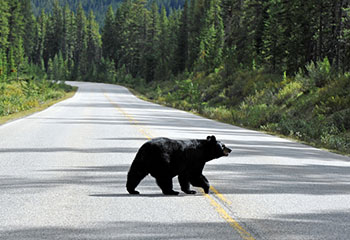 Wildlife fences in combination with wildlife crossing structures are the most effective and robust measure to improve human safety through reducing collisions with large mammals, and to provide safe crossing opportunities for wildlife. However, in multi-functional landscapes, access roads for agriculture, dispersed housing, and other roads result in openings in the fence. Along US Hwy 93 North on the Flathead Indian Reservation, wildlife guards (similar to cattle guards) at access roads have proven to be a substantial barrier to deer species (about 80% to nearly 100% barrier), but unfortunately they are quite permeable to species with paws, including bear species (about 50% to nearly 100% permeable). In addition, animals that do end up in the fenced road corridor must be able to escape quickly. Earthen mounds built up against the fence allow animals to jump down to the safe side of the fence. However, deer use of these wildlife jump-outs has been low (only about 32% use by mule deer, only about 7% use by white-tailed deer). This means that these animals spend more time inside the fenced road corridor before they exit, either at one of the jump-outs or at a fence-end. To further improve human safety, and to reduce direct road mortality of wildlife, including grizzly bears, additional measures are needed at access roads, and deer species need to use the jump-outs more readily.
Wildlife fences in combination with wildlife crossing structures are the most effective and robust measure to improve human safety through reducing collisions with large mammals, and to provide safe crossing opportunities for wildlife. However, in multi-functional landscapes, access roads for agriculture, dispersed housing, and other roads result in openings in the fence. Along US Hwy 93 North on the Flathead Indian Reservation, wildlife guards (similar to cattle guards) at access roads have proven to be a substantial barrier to deer species (about 80% to nearly 100% barrier), but unfortunately they are quite permeable to species with paws, including bear species (about 50% to nearly 100% permeable). In addition, animals that do end up in the fenced road corridor must be able to escape quickly. Earthen mounds built up against the fence allow animals to jump down to the safe side of the fence. However, deer use of these wildlife jump-outs has been low (only about 32% use by mule deer, only about 7% use by white-tailed deer). This means that these animals spend more time inside the fenced road corridor before they exit, either at one of the jump-outs or at a fence-end. To further improve human safety, and to reduce direct road mortality of wildlife, including grizzly bears, additional measures are needed at access roads, and deer species need to use the jump-outs more readily.
Project Overview
Proposal
Annual Meeting Presentation
Reports
Jump-Outs – Interim Report
Electrified Barriers - Interim Report
For more information, contact
